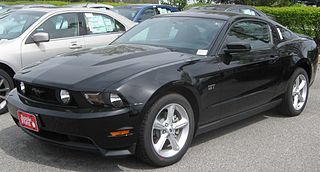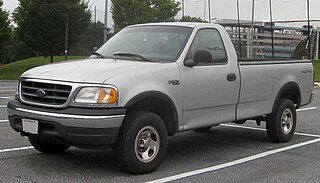Related Research Articles

An axle or axletree is a central shaft for a rotating wheel or gear. On wheeled vehicles, the axle may be fixed to the wheels, rotating with them, or fixed to the vehicle, with the wheels rotating around the axle. In the former case, bearings or bushings are provided at the mounting points where the axle is supported. In the latter case, a bearing or bushing sits inside a central hole in the wheel to allow the wheel or gear to rotate around the axle. Sometimes, especially on bicycles, the latter type of axle is referred to as a spindle.

The Ford Explorer is a range of SUVs manufactured by Ford Motor Company since the 1991 model year. As the first four-door SUV produced by Ford, the Explorer was introduced as a replacement for the two-door Bronco II. Within the current Ford SUV range in North America, the Explorer is slotted between the Ford Edge and Ford Expedition. As with the Ford Ranger, the Explorer derives its name from a trim package previously offered on the Ford F-Series pickup trucks.

The Ford D2C platform is one of Ford's rear-wheel drive automobile platforms.

The Ford Expedition is a full-size three-row SUV, manufactured by Ford. Introduced for the 1997 model year as the successor of the Ford Bronco, the Expedition was the first full-size Ford SUV sold with a four-door body. For its entire production life, the Ford Expedition has been derived from the corresponding generation of the Ford F-150 in production, sharing some body and mechanical components. The fourth-generation Ford Expedition began production for the 2018 model year. Similar to the configuration of the Chevrolet Tahoe and Suburban, the Ford Expedition is sold in regular and extended lengths ; sold since 2007, the latter functionally serves as the replacement for the Ford Excursion.

The Ford Excursion is a heavy-duty SUV that was sold by Ford from 2000 to 2005. At the time of its introduction, the Excursion was the longest and heaviest SUV ever to enter mass production. The third Ford SUV derived from the F-Series pickup trucks, the model line used a heavier-duty chassis and frame than the Expedition; both vehicles competed against the Chevrolet Suburban.

The Lincoln Navigator is a full-size luxury SUV marketed and sold by the Lincoln brand of Ford Motor Company since the 1998 model year. Sold primarily in North America, the Navigator is the Lincoln counterpart of the Ford Expedition. It is the heaviest production Lincoln ever built, and is also the Lincoln with the greatest cargo capacity and the first non-limousine Lincoln to offer seating for more than six people.
Special Vehicle Team, also known as SVT, was an arm of Ford Motor Company responsible for the development of the company's highest-performance vehicles. Established in 1991, SVT was the successor to the SVO division. The last SVT Director was Hermann Salenbauch. SVT was previously led by Hau Thai-Tang (2004–2007) and John Coletti (1993-2004). In 2015, Ford Racing, alongside Ford Team RS and Special Vehicle Team, merged into a global entity named Ford Performance.

The Ford Explorer Sport Trac is a pickup truck that was manufactured and marketed by Ford Motor Company for the North American market. The first mid-sized pickup truck produced by Ford, the Sport Trac was marketed from the 2001 to the 2010 model years. Sized between the Ranger and the F-150, the Sport Trac largely competed against crew-cab variants of the midsize Chevrolet Colorado/GMC Canyon, Dodge Dakota, Nissan Frontier, and Toyota Tacoma.

The Ford Mustang Mach 1 is a performance-oriented option package of the Ford Mustang muscle car, originally introduced in August 1968 for the 1969 model year. It was available until 1978, returned briefly in 2003, 2004, and most recently in 2021.
The GM 10.5" 14-bolt differential stands as a robust drivetrain component extensively featured in Chevrolet and GMC trucks, SUVs, and vans from 1973 onward, including specific versions of the Cadillac Escalade. Introduced in 1973, this differential employs a full-floating design, boasting a substantial ring gear diameter measuring 10.5 inches. Its nomenclature, "14-bolt," represents the 14 bolts securing the differential cover, although the ring gear itself is fastened by 12 bolts. Notably, the 14-bolt differential gained traction among Jeep Wrangler owners seeking axle replacement options, earning the moniker "corporate" 14-bolt because of its association with GM's corporate structure during the 1970s.

The fourth-generation Ford Mustang is an automobile that was produced by the American automobile manufacturer Ford Motor Company for the 1994 through 2004 model years. Marking the first major redesign of the Ford Mustang in fifteen years, the fourth generation of the pony car was introduced in November 1993 with the launch taking place on December 9, 1993. The design, was based on an updated version of the Fox platform and was the final vehicle underpinned with this platform. It featured styling by Bud Magaldi that incorporated some stylistic elements from the classic Mustangs. A convertible model returned, but the previous notchback and hatchback bodystyles were discontinued in favor of a conventional 2-door coupe design.

The Dana/Spicer Model 60 is an automotive axle manufactured by Dana Holding Corporation and used in OEM pickup and limited passenger car applications by Chevrolet, Dodge, Chrysler, Jeep, Ford and Land Rover. There are front and rear versions of the Dana 60. It can be readily identified by its straight axle tubes, 10 bolt asymmetrical cover, and a "60" cast into the housing. Gross axle weight ratings are often lowered by the vehicle manufacturer for safety and tire reasons. They are also lowered to reduce loads on other powertrain components such as transmissions and transfer cases. Dana 60 Axles are also increasingly swapped into many custom offroad applications to accommodate larger tires and deep compound gearing with locking differentials.
The Dana/Spicer Model 70 is an automotive axle manufactured by Dana Holding Corporation and has been used in OEM heavy duty applications by Chevrolet, Dodge, and Ford. It can be identified by its straight axle tubes, 10 bolt asymmetrical cover, and a "70" cast in to the housing and is visually similar to the Dana 60. The majority of the Dana 70s are rear axles, however Dana 70 front axles do exist. Both front and rear axle variations were first offered in 1957. The Dana 70 is generally regarded to have more strength than a Dana 60 but not as much as a Dana 80. Gross axle weight ratings are often lowered by the vehicle manufacturer for safety and tire reasons.

The Dana/Spicer Model 80 is an automotive axle manufactured by Dana Holding Corporation and has been used in OEM heavy duty applications by Chevrolet, Dodge, and Ford. It can be identified by its straight axle tubes, 10 bolt asymmetrical cover, and a "80" cast into the housing. Dana 80's are made as full floating, rear axles only and are a step up in overall strength compared to the Dana 70. 1988 Ford was the first company to use the Dana 80. The Dana 80 has a GAWR up to 11,000 pounds (5,000 kg), however it is common practice among manufacturers to derate Dana 80's. Gross axle weight ratings are lowered by the vehicle manufacturer for safety and tire reasons. The OEM Limited slip differential originally was a "Power Lok" until 1998 when the "Trac Lok" phased it out. Trac Loks were a $350.00 USD option with Ford Super Duty trucks. The Dana 80 Trac Lok is unique being it is a 4 pinion unit, unlike other Dana Trac Lok units with 2 pinions. This was the only rear axle available for the 2nd generation Dodge Ram 3500 trucks.

The Dana/Spicer Model 50 was an automotive axle manufactured by the Dana Holding Corporation for 25 years and was used solely in OEM Ford applications. Dana 50's were made as front axles only until it was revived in rear solid axle configuration in the 2022 Ford Bronco Raptor. The Dana 50 has a "50" cast into the housing and is regarded to have more strength than a Dana 44, but not as much as a Dana 60. It was only produced in a reverse cut gear set aka a high pinion.

The Dana/Spicer Model 35 is an automotive axle. It has been manufactured by Dana Holding Corporation since 1985 when American Motors (AMC) sold its axle tooling equipment to Dana. The axle was named AMC-15 when it was first made in 1962. Dana upgraded the axle, and added IFS and Twin Traction Beam front axle variations.

The Sterling 10.5 axle is an automotive axle manufactured by Ford Motor Company at the Sterling Axle Plant in Sterling Heights, MI. It was first used in model year 1985 Ford trucks. The axle was developed to replace the Dana 60 and Dana 70. The Sterling 10.5 axle is currently only made as a full floating axle.
The Ford 9-inch is an automobile axle manufactured by Ford Motor Company. It is known as one of the most popular axles in automotive history. It was introduced in 1957 model year cars and ended production in 1986, having been phased out in favor of the Ford 8.8 inch axle. However, aftermarket companies still produce the 9-inch design. It is a semi-floating drop-out axle and had a GAWR up to 3,600 lb (1,630 kg).

The tenth generation of the Ford F-Series is a line of pickup trucks produced by Ford from the 1997 to 2004 model years. The first ground-up redesign of the F-Series since 1979, the tenth generation saw the introduction of an all-new chassis and a completely new body. In a significant model change, the tenth generation was developed only for the F-150, with the ninth-generation F-250 and F-350 replaced by the all-new Ford Super Duty variant of the F-Series for 1999. An all-new crew-cab configuration debuted in 1999 for the 2001 model year.
References
- ↑ Incomplete list. Common applications only.
- ↑ "Ford Rear Axle Assembly Identification - Page 16 - FORDification.com". www.fordification.com. Retrieved April 6, 2024.
- ↑ "Guide To Ford Truck & SUV Axles" . Retrieved May 24, 2023.